Posted by Patrick Weiler on 11-15-2003 02:20 PM:
Sharing and Comparing
Steve,
When the internet became fashionable several years ago, I did
not have a computer, but I did have a few rugs (some of which I still
have).
I had a couple of opportunities to access the internet and the first
thing I looked for was oriental rugs. This was in the early 90's.
There were
already a number of rug dealers with web sites, but the stock did not change
very often and they were more or less web advertisements for the brick and
mortar stores. e-bay was not around then.
I had begun to subscribe to Hali in
1990, with issue #50.
I believe ORR was still being published, but not for
long.
So, with only one publication available, and only every couple of
months, it was a rather pathetic hobby to collect rugs.
There was no rug
club where I lived.
There were a few stores that had some old rugs, but how
often can you go to your local rug store and 'just browse" before they begin to
think you are a stalker or something? ( I was visiting one store when a guy came
in to sell a stolen rug. The dealer said he was sure it was stolen and the guy
high-tailed it out of there.)
So, when Tom Stacy began Turkotek, it was a
breath of fresh air. He had some very nice rugs and good information about them.
One could actually "browse" without the hassle of traveling to a store and find
a lot of different rugs without bothering the poor, overworked owner wishing a
'real" customer would come in.
I got my own computer and added several dozen
rug store sites and a couple of discussion boards to my Favorites list.
It
was beginning to seem like the rug world was more accessible.
When Turkotek
began to dissolve, it was a big loss. There were a few comments about it on one
of the early rug discussion boards. Would there truly be a place on the internet
to share and compare rugs, or was it just going to be another medium not
suitable for rugs?
Then, like a rescue ship appearing silently out of the
mist to save a foundering castaway from a watery grave, the New Turkotek
materialized.
I was afraid that, with the name Turkotek, it would be a site
devoted to only the popular Turkmen rugs and trappings. But it wasn't. And
Turkotek moved to the top of my Favorites list.
It was now a lot easier to be
a rug collector, and more fun because anyone could contribute, share and
compare.
Just as we now regularly check our e-mail (something that did not
really exist for most people a decade ago) we also check our favorite web sites.
It has become a lifestyle.
Next thing you know, there will be 12 step help
groups doing interventions to reduce our dependence on Turkotek.
Patrick
Weiler
Posted by Bob Kent on 11-16-2003 10:19 PM:
show and tell: design-degeneration articles ond demand!
I think the best salons here (tuning fork and many more) do a nice job of
comparative asthetics on some particular type of rug, like the Yomut (steve) and
Jaf (M Hopkins) articles in ORR. very helpful!
And show and tell can
almost provide design-degeneration articles on demand (with my rug in a
predictable "after" role), some people here know a great amount and have access
to so many images.
I live close to the great set of rug books (near
complete set of Hali, etc) at U Penn, NYC, Textile museum,etc but Turkotek is
still indispensible.
Posted by David R.E. Hunt on 11-21-2003 06:37 PM:
Collectors Gallery?
Patrick, Bob, and All- The title of this post brings to mind what I
think
is one of the nicest features I've seen on any web site-
the New England Rug
Society members Online Exhibition
Gallery.
Might some of our members be
willing to put their best foot
forward and share some examples from their
collection? The
possibilities seem to be near endless- classified by region,
type,
age ,ect.. Or perhaps their not so best foot forward, as in what
to
avoid- I sure could help out here. There would have to be
some form of
selection process and perhaps some photo
standards. Just thought I might put
this idea out there- Dave
Posted by Patrick Weiler on 11-23-2003 11:19 PM:
New Rug Club
David,
Are you suggesting that Turkotek is a de facto rug club? And
that we are having monthly meetings (salons)? And now that this tyro rug club is
5 years old, that we ought to have an exhibition?
I suspect that members of
the "peanut gallery" (those folks who consider "positive feedback" to be a full
contact sport) would have a field day with our selections.
If such an
exhibition were to come to fruition, quite likely each rug in the exhibition
could be a show-n-tell of its own. Or the whole thing would be "too much to
digest" as has been said about some of John Howe's Saturday Morning reports,
generating a paucity of comments due to the plethora of pieces.
Perhaps a
"focused" show-n-tell might work. A particular "type" of rug could be put
forward for discussion and people could post their rugs of the type for
discussion. Maybe we could even vote on which is considered the best  and which one wins the David Hunt prize
for the
and which one wins the David Hunt prize
for the  Rug to Avoid of its
type?
Rug to Avoid of its
type?
Patrick Weiler
Posted by Steve Price on 11-24-2003 08:37 AM:
Hi Patrick
You wrote, Perhaps a "focused" show-n-tell might work. A
particular "type" of rug could be put forward for discussion and people could
post their rugs of the type for discussion.
That's a GREAT idea! We
could call those things Salons, and open a new one every month.

Regards
Steve
Price
Posted by David R.E. Hunt on 11-24-2003 09:09 PM:
In Response to Your Many Queries
Dear Patrick and All- In all seriousness, this online gallery is really a
nice feature, and requires no feedback at all from the spectator- just an
opportunity to view some excellent and/or interesting examples of variuous
weavings. Yes i'll admit it, I do have some alterior motive in this, just as
some of the NERS pieces show up for sale in other venues, but mine is not of
profit.
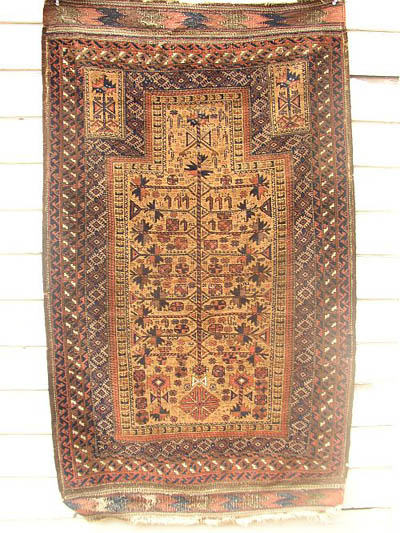
I bought this Belouch prayer rug some 2 yrs ago and have been
trying to find any of simular design, especially in regards to this halo of
peacock heads which seems a modification/suggestion of the rams horn mihrab as
demonstrated in this, plate # 24 from Michael Craycraft's Belouch Prayer Rugs.
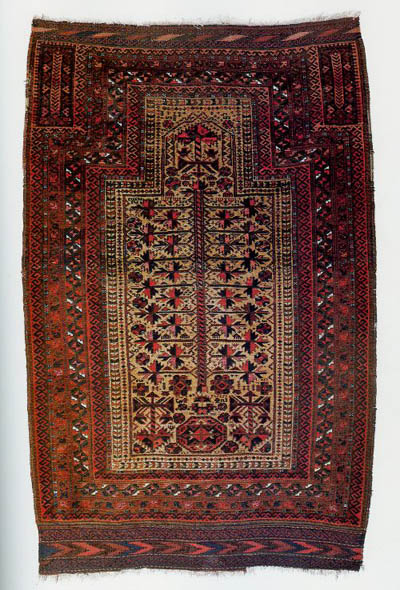
I've been scouring the internet looking for analogs but so far
no luck. Have posted it on a couple of sites but have gotten only minimal
exposure- or so it seems- and little feedback. In short, I'm just another
Turkomaniac in search of an
information fix.
Dave
Posted by Sue Zimmerman on 11-25-2003 10:41 AM:
Hi Dave,
In P.R. Ford's "Oriental Carpet Design" (paperback edition),
page 111, plate 247 is a rug kind of like yours. Sue
Posted by David R.E. Hunt on 11-25-2003 05:45 PM:
One of Many
Sue- Thanks so much for the pointer- I've the book and am familiar with the
plate- a very attractive rug.
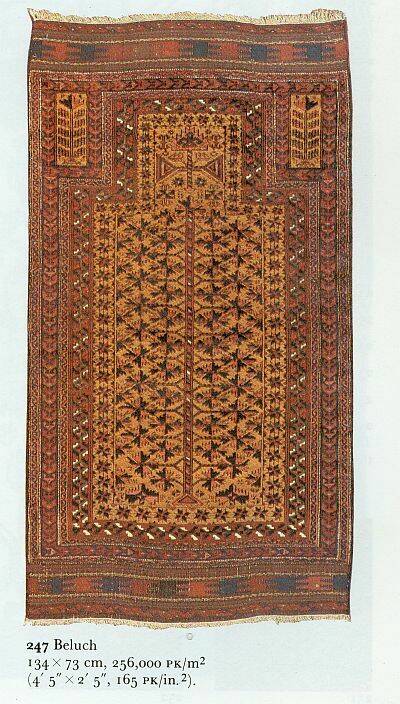
Also one quite simular to
mine on page 119 of Joyce C. Ware's Official Identification and Price Guild.
Also on the de Young Museum
Image Database found in the links section here at
Turkotek-search "baluch prayer rug"- couple of beautiful rugs from the H. McCoy
Jones Collection- but none with the peacock halo- the search continues-
Dave
Posted by Richard Farber on 11-29-2003 03:45 AM:
Dear Turkonians,
Mr. Hunt, perhaps you could organize a close up of
the peacock halo.
hard to see what you mean if you dont know where to
look . . . are you refering to a circle of heads [look like girafe's heads
:>} ] that also appear further down in the rug
???
sorry
Richard Farber
Posted by David R.E. Hunt on 11-29-2003 03:02 PM:
Peacocks?
Dear Richard and All-
The so christened peacock halo. There does seem
to be a
procession of these heads across the trunk of this Tree of Life
as
well.
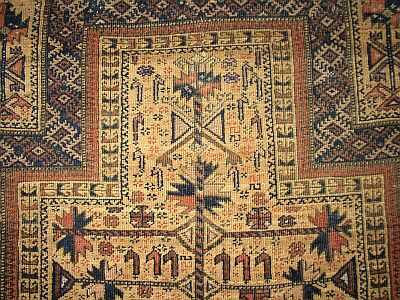
It is my understanding that these disembodied heads are a
representational device by which the entire animal is
suggested.
They might be camels, or even roosters as suggested by some,
the rooster supposidly of totemic significance to Baluchi.
But
the peacock, in respect to this weaving, seems most
probable, with it's
long history of association with the sylvan, let
alone the top knots or
crests.
This Shasevan flatweave from Opie's "Tribal Rugs",
is
decorated by a procession of, animals, some of which Opie
describes as
peacocks with "S" emblazioned on their tails.
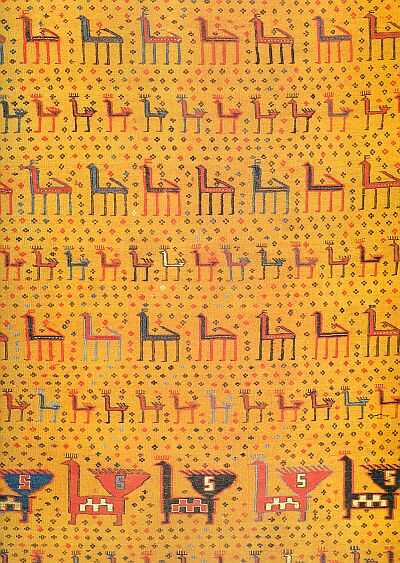
Note the simularity
to the peacock figures from the Shasevan
flatweave demonstrated by this
beautiful Baluch bag face-
property of one of our moderators if I am not
mistaken.
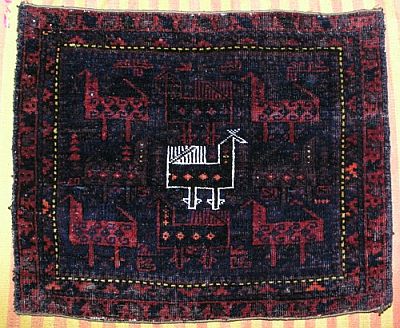
This does not, ofcourse, prove conclusively that these are
peacock heads, but I think we are moving in the right
direction.
Incidently, a more detailed study of this rug is to be found
in a
previous Salon discussion- Dave
Salon
Link
Posted by Patrick Weiler on 11-29-2003 09:12 PM:
David,
I think you are saying that the "floating bird heads" in the
mihrab are what you call a "peacock halo".
I am unable to make them out at
"the trunk of this Tree of Life", although I can see several in the branches of
the tree near the top of the field.
We western world people sometimes collect
the trophy heads of animals we have killed. In the Arctic north of Alaska, you
will often find a collection of antlers from caribou decorating the front of
homes, as well as the heads themselves - slowly dessicating in the arid
atmosphere.
Could your Peacock Prayer Rug be a trophy rug? Many guns from the
19th century in the U.S. show a carved mark indicating the number of enemies
killed with that gun. Maybe the wife of the weaver was a renowned
hunter.
Speculatively,
Patrick Weiler
Posted by David R.E. Hunt on 11-30-2003 06:30 AM:
Peacock Under Glass?
Patrick- Do people really eat peacock ?-Dave
?-Dave
Posted by Steve Price on 11-30-2003 07:01 AM:
Hi All
The Belouch bagface with the 9 birds was once Marvin Amstey's,
and now hangs on the wall next to my computer monitor at home. It mediated my
introduction to Marvin, and I'd like it a lot even if I had no other reason to
do so.
Conventional wisdom is that the birds on such bagfaces are
peacocks; I hold the minority opinion and believe that they probably represent
fighting cocks. Making a long story short, my reasons are:
1. I'm not aware
that the Belouch placed any significance on peacocks, and may not even have
known that they exist.
2. Cockfighting is a popular sport in the Belouch
group geographic area.
3. The fighting cock is said to be a symbol of
authority in the part of the world in which the Belouch live.
4. The spurs on
the legs are very prominent on the birds of Belouch "bird bags". Spurs are the
fighting cock's weapons, but are of no special significance for
peacocks.
Regards,
Steve Price
Posted by David R.E. Hunt on 12-01-2003 01:35 AM:
If It Walks Like A Duck...
Turkotekkers All- I didn't realize that this Game Cock figured so prominently
in the Baluchi culture, but to judge from the frequency with which one
encounters this rooster figure, as in this saddle from Opie's Tribal rugs and
from numerous soffre, I guess I shouldn't be suprised.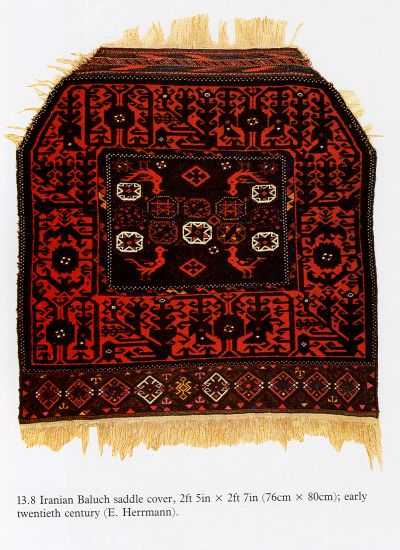
I've noticed that Opie,
in same said Tribal Rugs refers to this bird design as demonstrated by Steve's
bagface as being a peacock, displaying a rug with a strikingly similar avian
theme sans leg spurs. Having grown up living next door to a working dairy farm
in that one time rural agrairian communityof Germantown Maryland, now better
known for it's rows of town houses than it's rows of feed corn, I've a little
personal experience with both feathery denizens.
A couple of my neighbors
raised peacocks, a sort of novelty, which when subjected to the type of feed
schedule afforded by the free range scrounging of farm life take on the
appearence of a scrawny turkey. And they have enormous leg spurs. Much as with
the turkey, what strikes me as being the most primary and superficial
differientating characteristic of both peacock and common chicken
(comparatively), is that of the proportional relationship of body to tail.
Peacock tail plumage is at least twice the length of the body, and in the
typical barnyard fowl they might be closer to equidistant.
My father, school
Departrment Head and instrumential music instructor for the Montgomery County
Public School system for many years ( professional musician too Dad's Site)
recieved of all things the gift of a Fighting Cock from his students ( somehow
associated with marching band and football ) and so had such as a pet for a
number of years. Their plumage is quite colorful, and in all, combined with
their stature, makes for a rather impressive animal- for a chicken at any
rate.
Proportional relationshipos between body and tail are, I believe, those
characteristics which will distinguish the cock from the peacock, and if we
refer back to the yellow ground flatweave from Opie it is readily apparent that
two forms of birds are depicted, here distinguished by length of leg and
length/size of tail. Not withstanding a representative flamingo or crane as
extraneous variable, it might be fair to assume the depicted fowl peacock and
cockrel. But this is Shasavan, not Baluch, and while the two may share some
cultural affinity, they are not the same.
I have to admit that much of what
I've seen in Baluch more resembles chicken than
peacock- so why the "peacock
halo" theory- they may as well be roosters? Owning to the ambiguity of the
disembodied head device they could well be camels, or even of fowl in general,
seeing as they figure so prominently in Islam and symbolism in general.
I
believe the key to this riddle lies in the design itself. Does it represent an
Islamic Tree of Life, or a more preimordial commentary upon trees in general? Is
this design indigenous to the Baluch, or does it represent an advancec state of
development, in which external influences, religious or artistic have been
grafted upon or represent embelishments of the simple tree design? To Mr Michael
Craycraft, the author Of Baluch Prayer Rugs, which I understand to be the
definitive treatment of this subject to date, I owe most. While it is true that
I have found much on the net, more than anything it has been his book which has
helped me to put this rug into perspective and shaped my understanding of the
subject- as such, a considerable amount of the following of the following are as
much his ideas as mine.
While as a general rule it is true that crowding of
design elements in Baluch rugs are representative of late manufacture, it seems
that early rugs can demonstrate intricate and complex designs- and relatively
high knot counts as well. 19th century rugs tend to be smaller-
I would
think anything much over five and one half feet to be suspect, but size seems
more tribe specific. Much white can be indicative of a later date, yet some
early rugs show considerable use. Color and use of color is most
important.
Of my rug I would venture a guess , based upon the colors which
appear to be natural, rich, geographically specific and a design which seems
sophisticated in some aspects yet awkward in others, as if from market
influences- or spontanieity- third quarter 19th cent.near areas of Turkmen
influence- Dave
P.S Michael Craycraft's WebsiteGalerie ArabesQue
Posted by Patrick Weiler on 12-01-2003 09:45 PM:
Hungry?
David,
Yes people did, and probably still do, eat peacocks and
peahens, along with their eggs.
This paragraph, from http://teaching.ucdavis.edu/nut120a/0024.htm
Food and
Archeology, Ancient Greece and Rome, shows some of what the ancient Greeks
ate:
"What constituted suitable food to the Classical Greeks, whether in
the
Greek "heartland" or throughout Mediterranean lands? Athenaeus preserved
the comment by Eubulus of Athens that "real food" consisted of items that
promoted health and physical strength, especially beef boiled in huge
quantities -- with generous portions of foot and snout -- and slices of
young pork sprinkled with salt.94 Still, a broad range of foods available
to Greeks throughout the Mediterranean can be identified.
Common
meats during Classical and Hellenistic periods included beef,
mutton, goat,
and pork. Wild game augmented meals, specifically, wild boar,
deer, hare,
and numerous varieties of domesticated and wild birds
including, becafico,
blackbird, bustard, chicken, coot, crane, cuckoo,
dove, duck, francolin,
goose, grebe, guinea-fowl, jay, lark, nightingale,
ostrich, owl, partridge,
peacock/peahen, pelican, pheasant, pigeon, quail,
starling, swan, thrush,
and wagtail.95-99"
Oh, and it tastes like chicken.
Patrick
Weiler
Posted by Kelvin Webb on 12-01-2003 09:51 PM:
Here is a balisht about 34 inches x 19 inches; c1870 ?
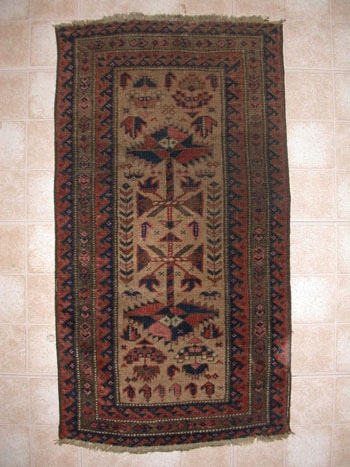
kelvin webb
Posted by David R.E. Hunt on 12-02-2003 06:11 AM:
Just When You Think Your Getting Somewhere...
Patrick,Kelvin, All-
Maybe the Peacock is the asian version of the
turkey-I
should have known.
Kelvin, thanks so much for sharing your
image. That copper red looks familiar, as does the overall green cast- I
especially like the border. And much as with those which I assume to be boteh or
leaf forms-those situated at the top, botton and centrally opposed on this
balisht- the so-called peacock heads of the prayer rug share the same cross
hairs at the base- yet they
don't all share the top knot. Leaf forms morphed
into animal heads? Enlongated leaves? Peacocks do have rather pronounced top
knots- but this in itself doesn't explain anything. These sure look like
kindered spirits to me- Dave
P.S. If anyone is interested I have posted
some large high resolution images of the prayer rug on Ian Stewart's
Yahoo
Group Rug Fanatics - They are listed in the Files section under
Paradise Balouch- You will I believe have to join the group to view but is
fairly simple process.
Posted by Patrick Weiler on 12-02-2003 11:29 PM:
chicken feet, peacock heads
David,
This link, from the University of Illinois, shows more than you
could ever want to know about chicken feet.
http://www.urbanext.uiuc.edu/eggs/res13-feet.html
The
relevant item is that the picture shows the three main toes on a chicken foot. I
believe that this is what the Baluch weavings show, not the added "spurs" that
fighting chickens wear, which can be seen in a photo at this web site from hotel
travel.com:
http://www.hoteltravel.com/philippines/cebu/guides/activities_sports.htm
Steve,
sorry to get so far afield from a discussion about the five years of Turkotek,
but one of the fascinating things about Turkotek is the tangents we find
ourselves exploring. Many times the tangent is more interesting than the
topic!
Patrick Weiler
Posted by Richard Tomlinson on 12-03-2003 03:24 AM:
and chicken's feet are delicious too.
sunday mornings down at hoi's
kitchen (hong kong style) for dim sum.
they steam them in a ginger and
black bean sauce. mmmmmmmm............
Posted by Steve Price on 12-03-2003 06:43 AM:
Hi Patrick
You wrote, ... sorry to get so far afield ... Many times
the tangent is more interesting than the topic!
Exactly. Many people
don't understand that this is not intended to be an academic, highly focussed
forum, but a conversation group involving people with overlapping expertises and
common interests.
Different Salon essays have different objectives. Some
are attempts to persuade others of the correctness of a particular point of
view, some are designed mainly to inform or to report some event, many are
simply introductory statements for conversations. One of the things I like to
see in Salon essays is obvious lead-ins for tangential topics. As you note, the
tangents are often more interesting and informative than the initial main
points.
Regards,
Steve Price
Posted by David R.E. Hunt on 12-04-2003 06:05 AM:
All- I agree, the birds on the bagface do look more like roosters, based upon
proportions alone, let alone the foot details.
Not withstanding, they could
also be so stylized as to ambuiguity.
Here are some images from Craycraft's
Belouch Prayer Rugs, just in the way of a quick survey of rugs from
differing time periods.
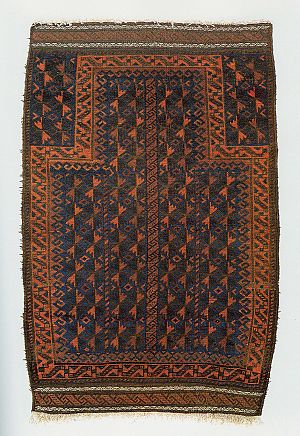
The first is pre 1850 and the earliest in the book.
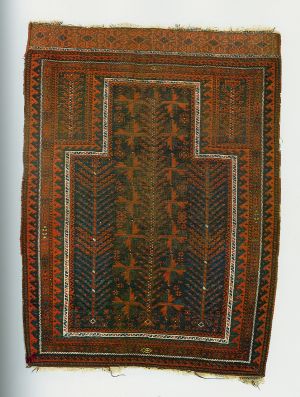
This
second piece is from third quarter of the 19th cent. and demonstrates the same
border (close anyway) as Kelvin's Balisht.
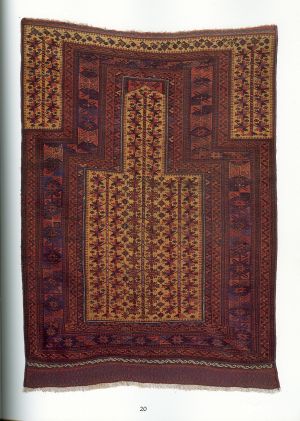
The third a camel ground ,
third quarter of century, 160 kpsi.
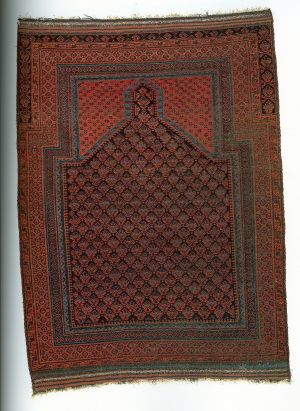
This last, an outstanding
example from the Dokhtor-e-Ghazi Tribe, mid 19th century.
Dave
Posted by Steve Price on 12-04-2003 06:45 AM:
Hi Dave
Thanks for the post. I'd like to make one small correction to
it before it gets too embedded in anyone's consciousness. That has to do with
the so-called "Dokhtor-i-Gazi" prayer rugs.
There is no evidence of any
geographic location or group of people called "Dokhtor-i-Gazi" or anything
similar, although the rugs given that name have remarkable similarities to each
other and clearly belong to the same group.
I've seen two translations
of "Dokhtor-i-Gazi", one being "daughter of the judge" and the other being
"daughter of the hero". Evidently there is a folk tale (perhaps a marketplace
myth, who knows?) that the first of these was made by such a woman, who then
made 22 or 23 more. I've seen more than 24 of them myself, so the number in the
folk tale can't be right, but there is probably a germ of truth in it someplace.
My best guess is that the daughter of a judge (or hero) created the first one,
wove some number more, and others in her family or community continued to make
them.
Regards,
Steve Price
Posted by Chuck Wagner on 12-04-2003 09:18 AM:
Language Lesson
Hi Steve,
No, it's judge, not hero. A "Qazi" is, in colloquial modern
use, a judge. It's a term common to Islamic populations and is found in Pashto,
Urdu, Arabic, Farsi, and many others. Originally, used to describe a clerical
scholar with well above average analytical skills who was chosen to apply Sharia
law.
Pronouncing it is a challenge for a newcomer to these parts. You
have to let your soft pallette float up tp the roof of your throat, kindalike
when one pronounces "khorjin" properly, but a harder "k"-like sound from down
the back of your throat.
Regards,
Chuck
__________________
Chuck
Wagner
Posted by David R.E. Hunt on 12-04-2003 07:34 PM:
Steve and All- Now that it has been called to my attention, I do seem to
remember this tale regarding the origin of the design, and thought that maybe I
should have said "of the Dokhtor-e-Ghazi design. I've both an the Comprehensive
Guide and a relatively new (Fourth edition) of Eiland's Complete Guide, and as I
am continually confusing them,I just reached for the nearst one, the Complete
guide, and looked up Dokhtor-e-Ghazi. Here is what I found-
Rugs of the
Dokhtor-i-Ghazi Baluchi, living to the north and west, are also marketed in
Herat, although some turn up in Iranian markets. They are usually woven in
prayer rug designs, with the field covered by simple, repetitive geometric
forms.
I'm perfectly willing to take your word for it, the book is
six years old, my textile bibliotique consists of a whole fourteen
titles,
and sans stumbling into the National Archive for a few hours several
years ago, the last time I visited a real library was in the stack room of
Mckledon Hall at the U. of M., and I don't want to even think about how long ago
that was - Dave
 and which one wins the David Hunt prize
for the
and which one wins the David Hunt prize
for the  Rug to Avoid of its
type?
Rug to Avoid of its
type?






 ?-Dave
?-Dave




